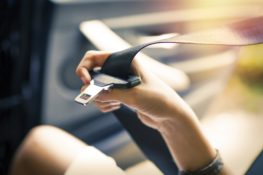
In short, YES, you need to wear a seat belt. Here is why. According to the National Highway Traffic Safety Administration seat belts saved an estimated 13,941 in 2015.
Almost half of the over thirty-five thousand people killed in vehicle crashes in 2015 were not wearing seat belts. The National Highway Traffic Safety Administration estimates that seat belts would have saved an additional 2,814 lives. Wearing a seat belt prevents you from being thrown from a vehicle with greatly increases your chances of surviving a collision.
Many people believe that airbags are enough to protect you in case of a car accident, however, this is not correct. In a collision failing to wear a seat belt may cause you to be thrown with strong force into a rapidly opening airbag. This may result in serious injuries and possibly death.
The NHTSA has guidelines for properly wearing a seat belt:
- The lap belt and shoulder belt are secured across the pelvis and rib cage, which are better able to withstand crash forces than other parts of your body.
- Place the shoulder belt across the middle of your chest and away from your neck.
- The lap belt rests across your hips, not your stomach.
- NEVER put the shoulder belt behind your back or under an arm.
The NHTSA also has guidelines for wearing seat belts if you are pregnant.
- The shoulder belt away from your neck (but not off your shoulder) and across your chest (between your breasts), making sure to remove any slack from your seat belt with the lap belt secured below your belly so that it fits snugly across your hips and pelvic bone.
- NEVER place the shoulder belt under your arm or behind your back.
- NEVER place lap belt over or on top of your belly.
It is recommended that when purchasing a new vehicle you check the seat belts to make sure that they fit well. In some cases, manufacturers carry seat belt adjusters to ensure a better fit.
The answer is simple – you should always wear a seat belt. Unfortunately, the usage rate of seat belts is only 90.1%. That sounds like a high percentage, but it still leaves approximately 27.5 million people that do not use seat belts.
The Seat Belt Dilemma: Millions Still Don’t Buckle Up
Despite the overwhelming benefits, 10% of Americans still don’t wear seat belts—that’s around 27.5 million people. This negligence not only puts their lives at risk, but it can also complicate personal injury claims after an accident.
How Herrman & Herrman Can Help
If you’ve been injured in a car accident—whether or not you were wearing a seat belt—it’s critical to have experienced personal injury lawyers on your side. At Herrman & Herrman, we understand the complexities of these cases. Insurance companies often try to minimize or deny claims, especially if a seat belt wasn’t used. Our team knows how to navigate these tactics and will fight to ensure you receive the compensation you deserve.
Car accidents are traumatic enough. Let Herrman & Herrman take on the legal burden so you can focus on healing. Contact us today for a free consultation and protect your rights.








